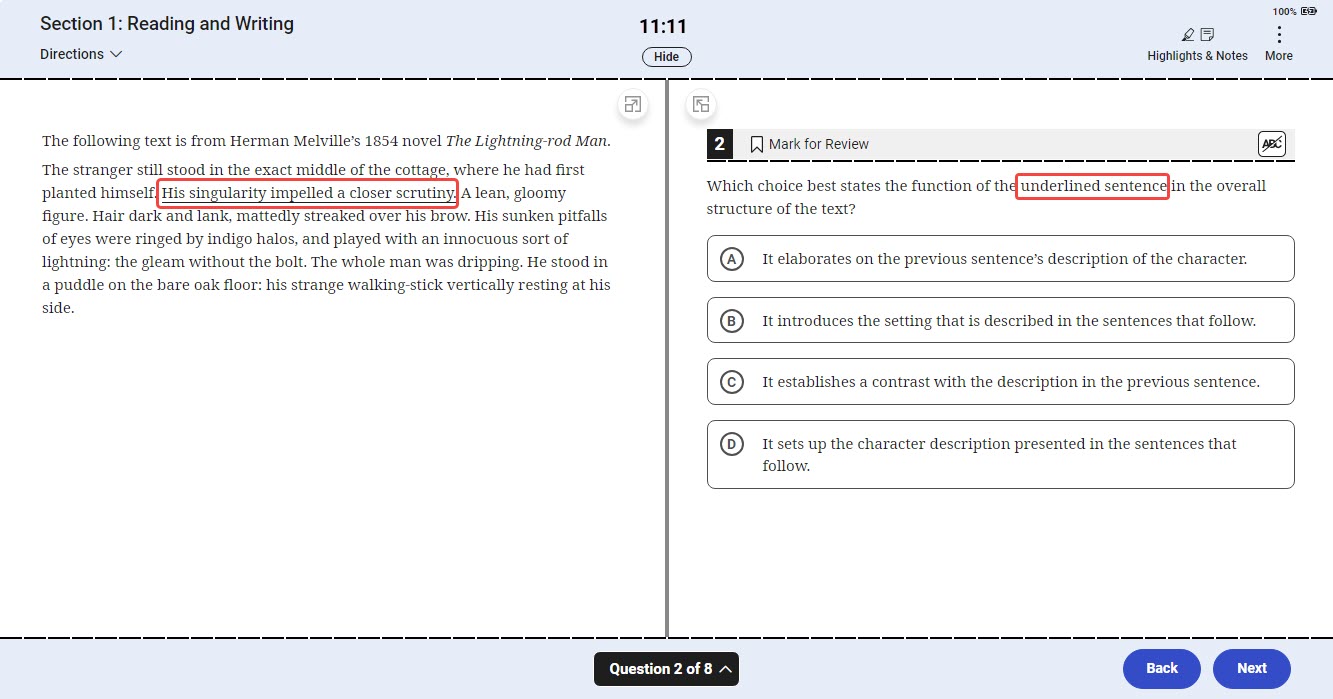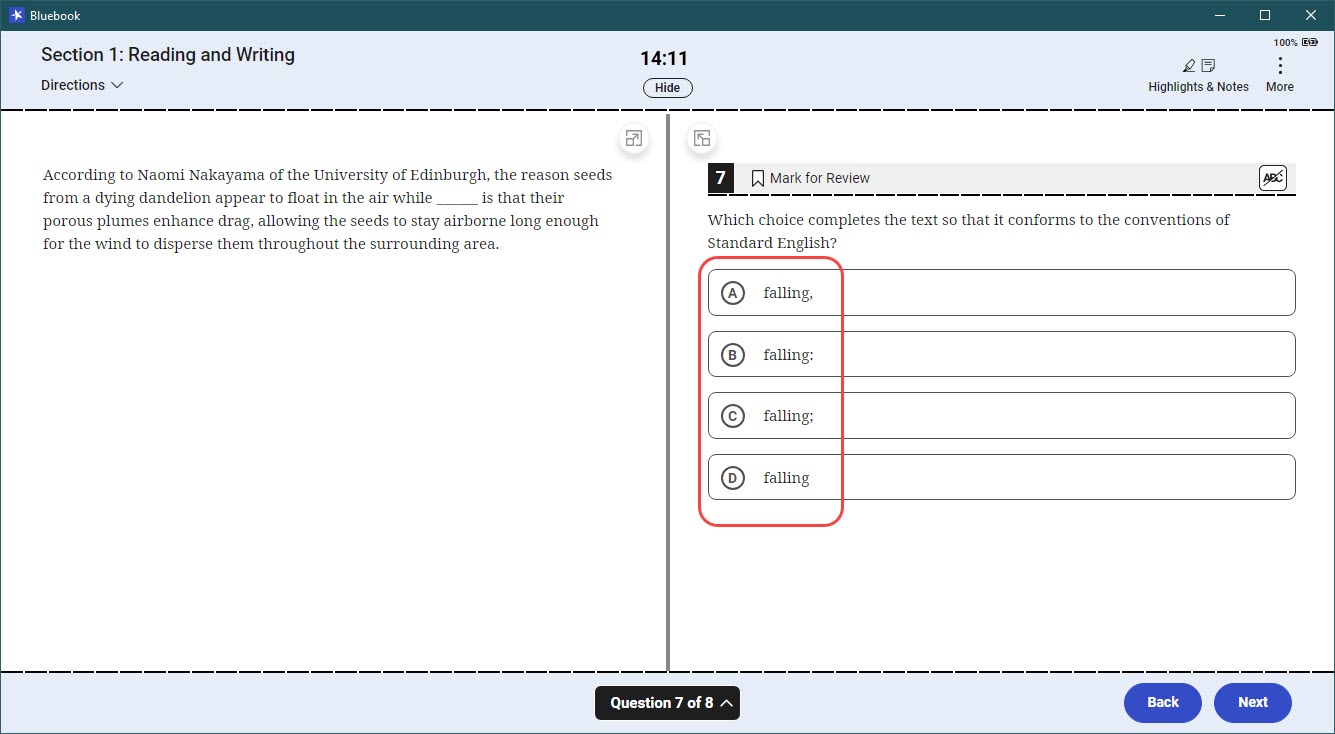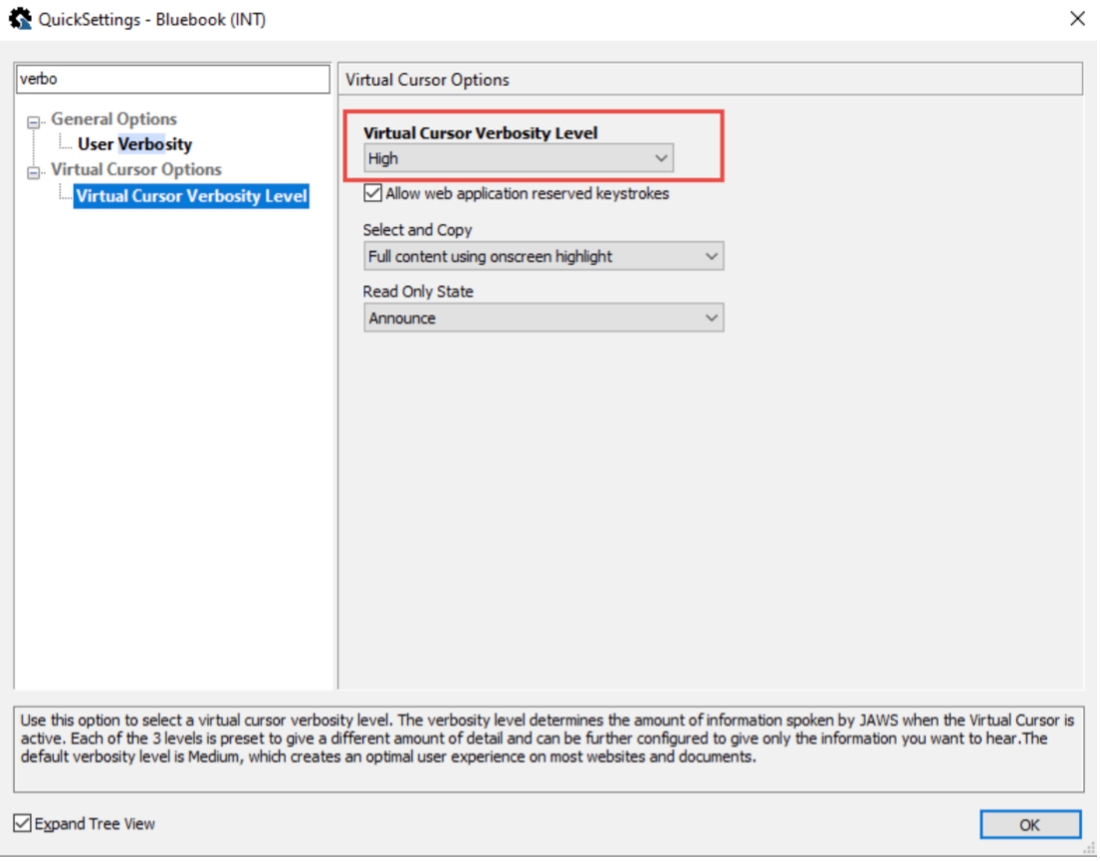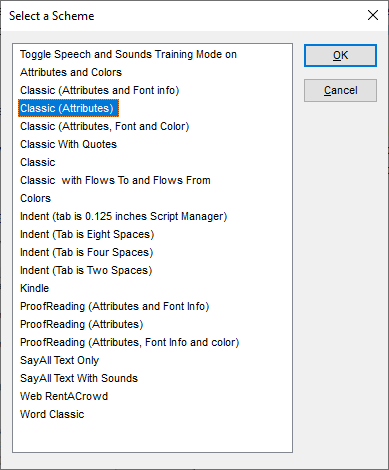JAWS
In Bluebook, if you use an external screen reader such as JAWS, you will use the typical/native commands you normally use to navigate a webpage. Most exam pages are structured with the following regions. Wherever applicable, you can navigate with these regions/landmarks:
- Bluebook Controls
- Test Timer
- Test Tools
- Passage, Image, or Other Source Content
- Footnotes
- Referenced Content
- Long Description
- Question and Answer
- Question Number
- Answer Options
- Question Navigation
In general, the following test components are defined with a heading:
- Test name
- Directions
- Passage title/poem title (when applicable), etc.
- Prompts for free-response questions (when applicable)
- Document title for document-based questions (when applicable)
- Algorithms and relevant steps (AP Computer Science Principles)
Recommended Verbosity and Punctuation Settings
Underlined “Referenced Content“ Text
Some questions within the SAT Reading and Writing section contain underlined text that is the focus of a question. The underlined sentences are structured as landmark regions and are identifiable and navigable with mainstream screen readers like JAWS, NVDA, VoiceOver, ChromeVox, and Narrator.
Answer Options with Differing Punctuation
Some questions within the SAT Reading and Writing section contain answer options that have varying punctuation characters. Some mainstream screen readers will not announce these punctuation characters by default. Users of screen readers like JAWS, NVDA, VoiceOver, ChromeVox, and Narrator must ensure that the punctuation settings are set correctly.
Configure the verbosity, punctuation, text processing, and other settings for each digital exam subject as needed. Configuration needs to be done before opening Bluebook to answer preview questions and again before exam day. You must ensure all settings are configured before beginning the test day check-in process in Bluebook. Follow these steps below:
Adjust the voice profile, speaking rate, verbosity, and punctuation settings before test day.
- With the Bluebook application, open activate the Run JAWS Manager for Bluebook (JAWS Key + F2 > choose Quick Settings):
- Go to Punctuation and select from the Punctuation Level drop-down list.
- A higher level of punctuation can be helpful for proofreading and editing.
- Some students find a lower level is less distracting for more casual reading.
- Apply Changes
- Go to Punctuation and select from the Punctuation Level drop-down list.
- Go to Virtual Cursor Verbosity Level:
- Configure the Virtual Cursor Verbosity Level to High so that regions within passages will be announced.
Optional Bluebook Verbosity Settings
Some exam questions have formatted text that is bold, underlined, or italicized, but it is not imperative that the formatting be conveyed to users of screen readers. Nonetheless, the College Board offers the following settings for the following screen readers. These settings are not enabled by default but can be enabled at the user's discretion so that text formats like bold, underlines, and italics are announced.
The JAWS Select a Scheme dialog allows users to choose whether the virtual cursor will announce text attributes. By default, the Classic scheme is enabled. The "Classic (Attributes)" option is one that the College Board Accessibility compliance Office (ACO) has used when testing the Bluebook application and content like AP English Literature.
To open the Select a Scheme dialog in JAWS, press JAWSKey (INSERT) + ALT + S.
Science, Technology, Engineering, and Mathematics (STEM) Content
Some STEM content within Bluebook exams may contain acronyms, chemical equations, camelCase, or PascalCase that need to be announced clearly or verbatim by screen readers. Below are specific screen reader commands that will announce capital letters distinctly with varying pitch or, depending on the screen reader and operating system, spell out the content character-by-character.
JAWS Screen Reader
- INSERT + Numpad 5 twice quickly.
- If using a keyboard without a numeric keypad, INSERT + K twice quickly.
- Refer to JAWS Reading Commands.
Move (Drag) Calculator and Reference Sheet with Keyboard
The built-in calculator and reference sheets in Bluebook can be moved with the keyboard. Navigate to the Move (Calculator or Reference) button with the Tab key. Place the Move button into a draggable or ”pressed” state by pressing the Space bar or Enter key.
Users of JAWS must ”pass through” the Space bar or Enter keystrokes to put the button into a pressed state.
- Press Insert (JAWS key) + 3 and then press the Enter key or Space bar to put the Move button into a pressed state.
- To move the calculator or reference dialogs, JAWS users may want to force PC cursor mode by pressing Insert + Z and then move the window with the Arrow keys.
- Press Insert + Z again to return the virtual PC cursor.



